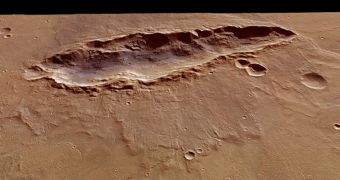While conducting routine investigations above the Southern Hemisphere of the Red Planet, a spacecraft was able to collect a wealth of data and numerous images of an elongated impact crater.
The amazing landscape feature was probably produced a long time ago, when a space rock impacted our neighboring planet at a shallow angle. Preliminary analyses of the crater suggest that there were several space impactors that made their way to the planet.
The European Space Agency (ESA) reports that the landscape feature is located just south of the Huygens basin. It was imaged using the Mars Express spacecraft that ESA operates around the planet.
According to astronomers, the southern highlands were battered with space impact, and are heavily cratered. The Huygens basin itself is filled with impact marks. The feature is some 450 kilometers in diameter, according to Mars Express data.
The elongated crater visible in the new ESA images is located at 21°S / 55°E. The view covers an area spanning 133 by 53 kilometers (82 by 33 miles). The European spacecraft observed it in great detail.
The smallest feature visible in the photographs is about 15 meters across. The views themselves were captured on August 4, 2010, but it was only recently that experts finished analyzing them.
ESA experts say that the peculiar, elongated crater “is about 78 km in length, opens from just under 10 km wide at one end to 25 km at the other, and reaches a depth of 2 kilometers.”
Since first discovering the structure, planetary scientists and geologists alike have been wondering as to the reason why it has this peculiar shape. One of the main clues came when experts looked at the ejecta blanket, the material that the original impact cast out.
This particular one “is shaped like a butterfly’s wings, with two distinct lobes. This hints that two projectiles, possibly halves of a once-intact body, slammed into the surface here,” ESA experts say.
But it could be that more than two objects struck Mars. Inside the actual crater, scientists discovered new evidence of three deeper areas, which may have been produced by subsequent impacts.
Supporting this claim is the discovery of yet another small crater to the northwest of the elongated one, that may have been produced by an impactor accompanying the original group.
“In addition, there are several small channels on the blanket, suggesting that the strike took place into a surface rich in volatiles, perhaps even water, that were melted by the heat of impact and flowed away,” ESA reveals in a press release.

 14 DAY TRIAL //
14 DAY TRIAL //